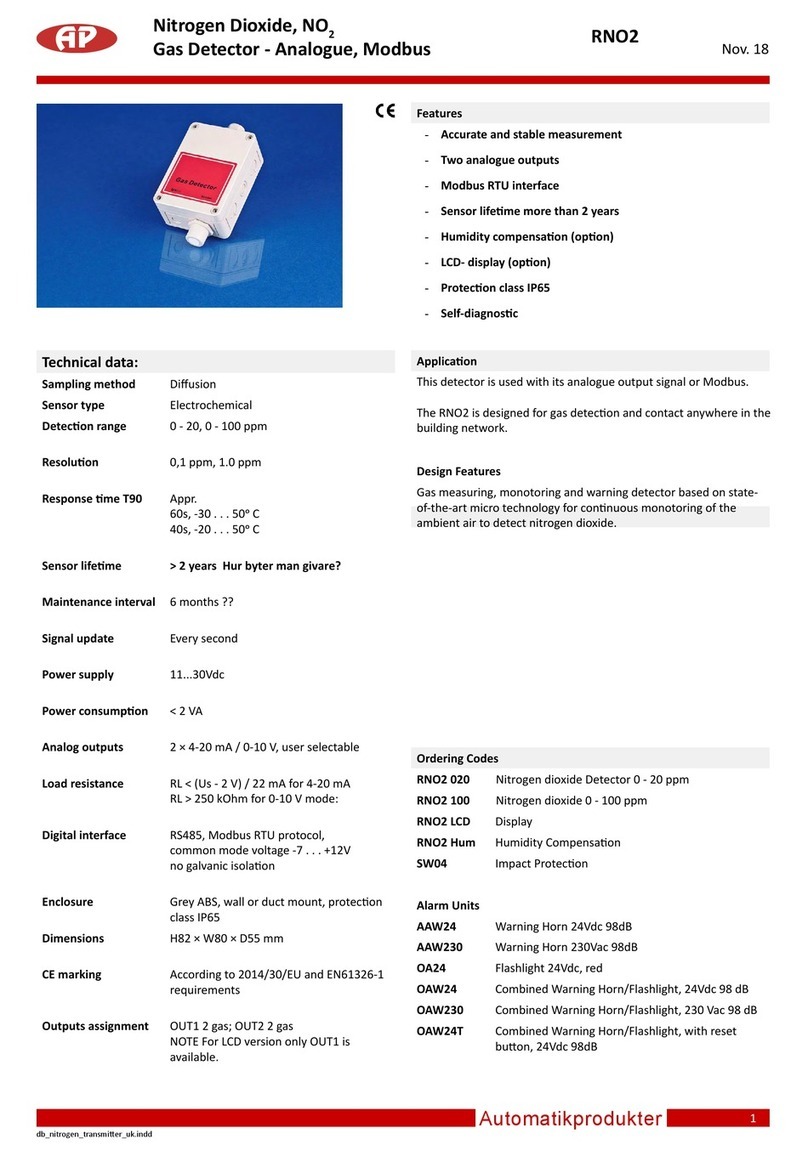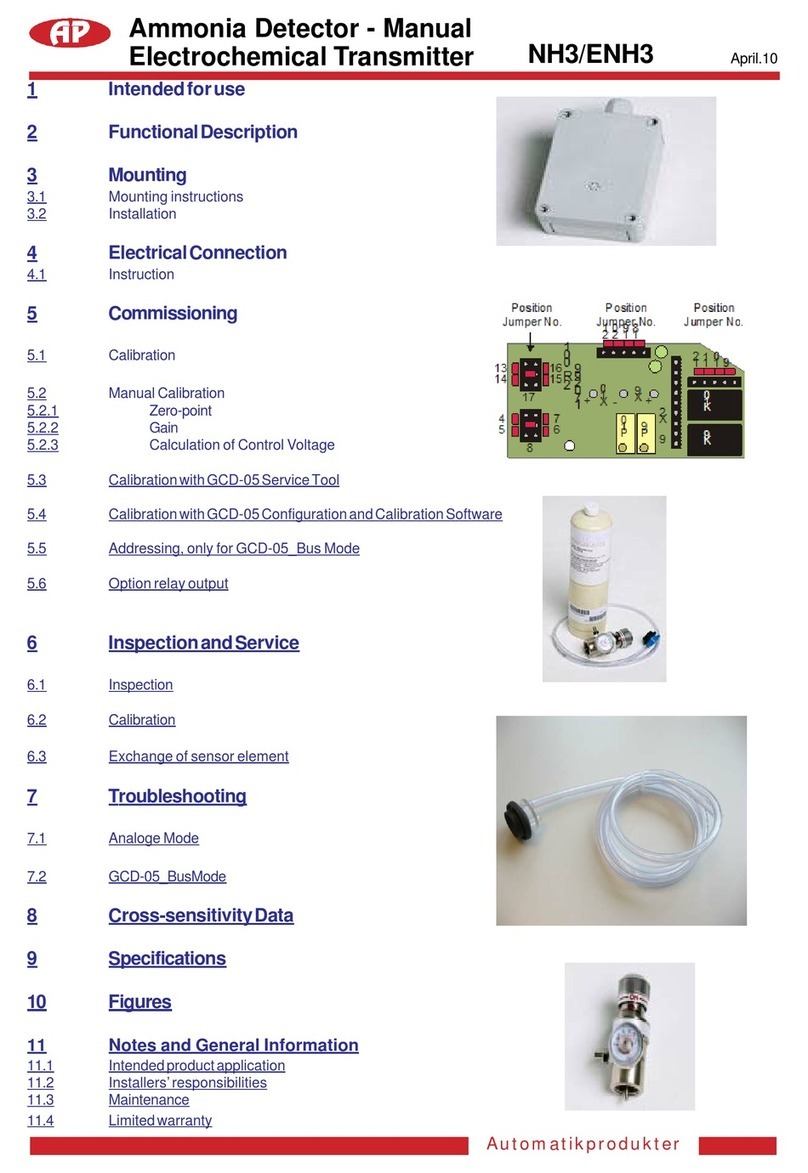
Automatikprodukter
3
Calibration (CO2)
IMPORTANT
This CDH has been factory calibrated and should
only need calibration once every 12 months. For the most
accurate field calibration possible we recommend
calibrating this sensor with the AP calibration Kit (part
number CD CAT) available from AP.
In the CDH Monitor, any sensor drift usually occurs at it zero
refernce point. The manual calibration process allows the user
to perform a one point calibration based on ambient levels or
by flowing a gas of a known concentration through the sensor.
This process will adjust the zero offset of the sensor and will
provide an accurate calibration. If for reason a two point
calibration is required the calibration kit or CO2ViewTM
software should be used. To manually calibrate the Model
CDH CO2sensor see instructions below.
1. The calibration procedure will last approximately
15 minutes. Before performing the calibration procedure,
remove the battery cover (see “Battery Installation”) to
provide access to the CO2calibration activation
switch.
Connect the supplied AC adapter to the back of
the sensor.
Ensure the sensor has new batteries or is powered by the
plug in transformer.
2. Power up the sensor and wait for the Warm-up to end.
3. Next verify the Elevation correction has been set.
Refer to the steps in Elevation Correction for procedure.
4. If you are calibrating to ambient conditions make sure the
sensor is displaying a stable reading. It is also very
importent to avoid breathing in the area of the monitor.
If you are flowing gas to the calibration port of the sensor,
allow the gas to flow for at least 10 minutes before initia
ting calibration.
5. Press the Mode button twice. The Calibration mode will
begin blinking.
6. Press Enter.
7. Use the Up/Down Rocker button to adjust the lower
reading on the display to the current ambient conditions.
Pressing the button once will change the readings in
increments of 10 ppm.
To increase the speed, press and hold the button.
NOTE
For best accuracy, a reference or known concentration of CO2
should be used when adjusting the reading.
8. Next, on the backside of the unit locate the push button
switch (under the battery cover, in the small round hole to
the right of the connector jack), use a small pointed object
to depress and hold the switch for 5 seconds.
The Calibration light will begin to blink.
9. Press Enter.
10. Calibration In Progress will begin to blink.
Temperature Adjustment
Use this procedure to adjust the temperature output when, for
example, you wish to have the temperature output match a
reference sensor.
The accuracy of a field adjustment is dependent upon the
stability of the environment is which the procedure is perfor-
med, and upon the accuracy of the reference sensor.
1. Before performing the temperature adjustment, connect
the supplied AC adapter to the back of the sensor. If
you do not have the AC adapter, new batteries should
be used.
2. Power up the sensor and, using the kickstand, place it
on a flat surface in a stable environment relatively free
of drafts or temperature changes. Wait 30 minutes for
the unit to fully equilibrate with the environment. Do not
hold the unit in your hand during this period.
3. Press the Mode button a number of times. until the
blinking word “TEMPERATURE” appears.
4. Press Enter. Both the word “TEM-PERATURE” and the
numeric temperature display will begin blinking in unison.
5. Use the Up/Down Rocker button to adjust the temperature
reading to match the reference.
6. Press Enter. The temperature offset is immediately
adjusted, the blinking stops, and the unit is now in normal
operating mode.
accurately display current room conditions.
Kickstand - The sensor is equipped with a kickstand which
can be used for desktop monitoring.
Using an External Datalogger - Voltage outputs for both CO2
and temperature are available via an RJ-45 jack on the rear of
the unit.
Ventilation Rate Indicator (cft)
Overwiew - To display the ventilation rate scroll through the
up/down button until the lower display provides a reading
showing ftm, which stands for cfm (cubic feet per minute). This
value represents how much outside air is being introduced on
a cfm per person basis in the space. Current codes and
standards generally require 15 to 20 cfm/person to be
delivered to most spaces to ensure acceptable indoor air
quality. Lower cfm/person values will indicate lower levels of
ventilation and potentially poor air quality. Higher levels will
indicate excessive ventilation and potential excessive energy
usage. Accurate interpretation of the ventilation rate indicator
requires a measurement be take 2 to 3 hours after occupancy
has stabilized in a space or at a peak in daily CO2
concentrations. In other conditions the indicator may tend to
over estimate ventilations rates. The calculation of ventilation
rates also assumes an office type of activity level (sitting some
walking and other low level activity). If activity levels are
higher the sensor will also underestimate the ventilation rate.
The CDH will calculate the outside air ventilation rate to a
space based on the inside/outside CO2 differential readings.
The sensor is factory set to assume an outside level of 400
ppm, which should be close to the outside concentration in
most areas. The outside level of CO2 can also be changed by
measuring outside levels or by manually adjusting the
monitor.
Adjustment - To measure readings, take the unit outside and
wait for levels to stabilize on the CO2display (should take
approximately 5 minutes). Once levels have stabilized, hold
the ”enter” button on the sensor for 5 seconds.
At this point the unit will program itself based on the CO2
value that was input in Step 6.
The calibration process will take approximately 5 minutes.
When Calibration is complete, the display will return to the
steady Calibration mode.
Press Enter to return to the normal operation mode.






















